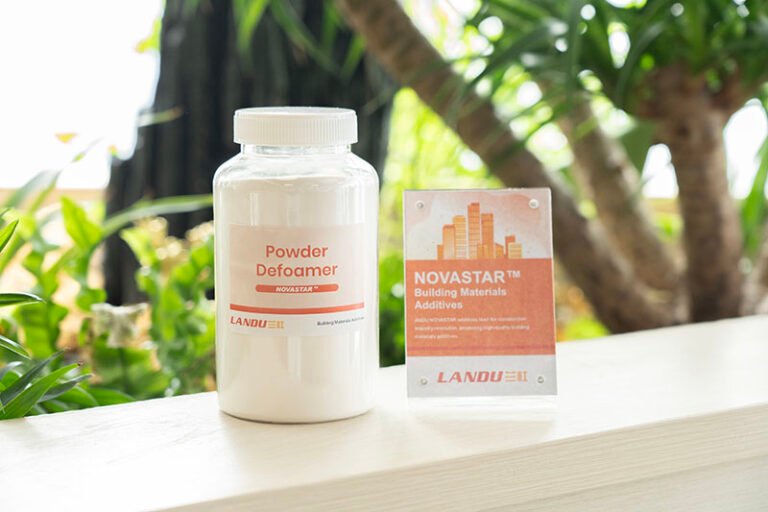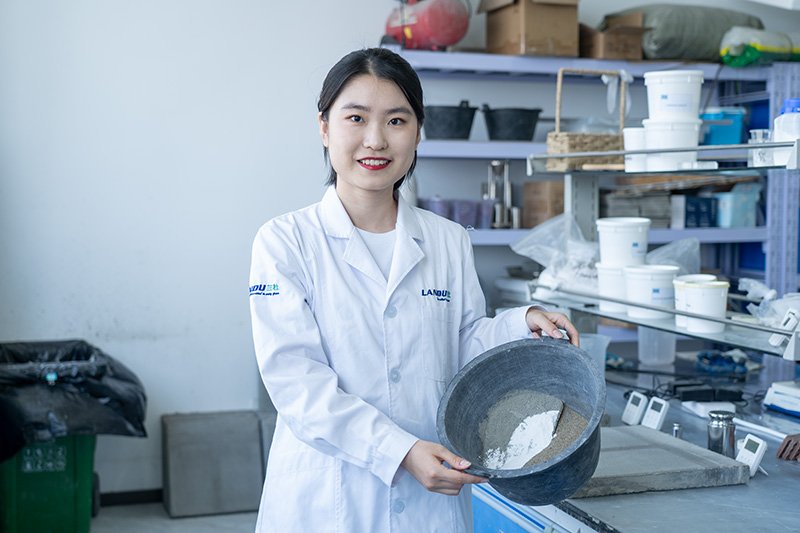Selecting the Ideal Polymer Composition
- VAE (Vinyl Acetate-Ethylene): Versatile Option with Fine Balance of Bonding, Pliability, and Expense. Ethylene Levels Tune Tg; Higher Ethylene Gives Better Low-Heat Pliability.
- VAE-VeoVa (Vinyl Versatate Blends): Enhanced Water Repellency and Alkali Tolerance; Strong Outdoor Longevity and Bonding to Lower-Energy Bases; Good Pick for Plasters and ETICS.
- Acrylics and Blends: Outstanding UV and Climate Tolerance, Very Good Bonding to Wide Base Range; Useful for Challenging Outdoor and Low-Pore Base Uses.
- Water-Repelling Types: Offered Across Compositions; Chosen for Proof Compounds, Low-Uptake Plasters, and Stain-Tolerant Fills.
Standard Quantity Advice (Starting Points; Always Lab-Confirm)
- Tile Bonds: 2–6% RDP on Dry Blend for Better Bonding; Higher for Pliable Levels.
- Plasters and Coats: 1–5% Based on Efficacy Goals (Bonding, Fracture Tolerance, Moisture Uptake).
- ETICS Underlayers: 2–6% Based on Mesh, Shock Level, and Environment Exposure.
- Proof Compounds and Fills: 3–8% with Water-Repelling Types, Plus Extra Repellents if Needed.
- Restoration Compounds: 2–6% for Bonding and Resilience; Moisture Reduction and Shrink Control are Also Key.
- Self-Smoothing Bases (SLU): 1–3% to Boost Bonding, Wear Tolerance, and Cut Dusting While Keeping Flow.
Synergistic Components and Their Interactions
- Cellulose Derivatives (HPMC/HEMC/HEC): Offer Moisture Retention and Usability; Vital for Open Time and Curing. They Also Affect Air Levels and Slump Tolerance; Choose Grade and Chain Mass for Your Task.
- Starch Derivatives: Alter Flow and Anti-Slump/Anti-Leak in Coats and Tile Bonds; Use Cautiously to Avoid Stickiness.
- Dispersants/Super-Dispersants: Lower Moisture Needs and Improve Packing; Beneficial for Potency and Permeability, But Watch Reconstitution and Layer Formation When Moisture is Cut Too Much.
- Bubble Suppressors: Control Air Levels; Excess Air Lowers Mechanicals and Raises Permeability.
- Repellents (Silane/Siloxane): Merge with Water-Repelling RDP to Push Moisture Uptake Even Lower; Mind Harmony and Amount to Prevent Surface Flaws.
- Mineral Aggregates: Granule Size Spread Governs Packing and Permeability; Pair Fine and Rough Fractions for a Compact Matrix That Augments RDP’s Layer-Forming Barrier Effect.
Preparation, Handling, and Preservation Best Practices
- Dry Mixing: Pre-Mix RDP with Aggregates to Prevent Separation; Keep Batch Heats Moderate to Minimize Clumping. Ensure Even Spread—RDP is Low Density and Gains from Enough Mixing Time.
- Dampness Management: RDP Attracts Moisture; Store in Sealed Packs in Dry Settings. Once Opened, Reseal Quickly. Moisture Gain Causes Clumping and Weakened Reconstitution.
- Site Blending: Add Water Per Suggested Ratio; Allow Enough Wetting Time for RDP Full Reconstitution; Avoid Over-Blending That Adds Air.
- Layer Formation Settings: Follow Lowest Application Heats; Cool, Damp Settings Slow Layer Formation and Can Leave the Polymer Phase Broken, Lowering Advantages.
Testing to Quantify the Advantages
Bonding and Climate Tolerance
- Pulling Bonding Potency Initial and Post-Conditioning (Water Soak, Warmth Maturing, Ice-Thaw Cycles).
- Shear Bonding Where Relevant (e.g., Stone Covers with Suitable Methods).
- Water Soak Peel Tests for Certain Unique Uses.
- UV and Moist-Heat Cycling for Outdoor Plasters and ETICS to Assess Preserved Bond and Look.
Pliability and Shock Tolerance
- Transverse Adaptability Rating for Tile Bonds (Pliable vs Highly Pliable).
- Shock Tolerance (e.g., Measured Falling Weight) for ETICS Underlayers; Assess Post-Moist-Heat Pre-Treatment to Mirror Site Conditions.
- Bending and Pressure Potency Ratio Checks on Plaster or Compound Samples to Grasp Resilience Gains.
Moisture Uptake and Permeability
- Pore Water Uptake (e.g., Partial Soak Over Time).
- Water Permeability Under Force for Proof Compounds Where Needed.
- Ice-Thaw with De-Icing Salts (for Flat Surfaces) When Pertinent.
Tile Bonds (Thin-Layer)
- Issue: Grip to Dense Ceramic and Endure Damp Zones and Heat Shifts.
- Approach: Mid-to-High Polymer Amount with Suitable Composition (Often VAE-VeoVa or Acrylic for Low-Uptake Ceramics), Water-Repelling Type if Fill Moisture Exposure is Common, Balanced Cellulose Derivative for Open Time Sans Slip.
- Result: High Initial and Preserved Bonding; Adaptability to Handle Motion; Reduced Moisture Uptake Along Fill Lines.
EIFS/ETICS Undercoat with Mesh
- Issue: Tolerate Shocks, Wind Pull, and Moist-Heat Cycling on Outdoor Insulation.
- Approach: RDP That Delivers Resilience and Good Grip to EPS/XPS and Mineral Bases, Polymer Amount Tuned to Mesh Density, Optional Water-Repelling Type to Limit Moisture Entry.
- Result: Strong Shock Level Rating and Prolonged Usability with Fewer Wall Flaws.
Single-Layer Plaster/Coat
- Issue: Minimize Fracturing, Boost Grip to Brickwork, Tolerate Rain.
- Approach: RDP for Bonding and Pliability, Water-Repelling Type or Added Repellent for Moisture Uptake Control, Optimized Aggregate Grading and Cellulose Derivative for Usability and Slump Tolerance.
- Result: Smooth Placement, Fewer Shrink Fractures, Enduring Surface with Lower Upkeep.
Cement-Based Proofing Compound
- Issue: Form a Watertight Barrier on Concrete or Brickwork Under Occasional Pressure.
- Approach: Water-Repelling RDP Merged with Repellents, Compact Packing, Controlled Water-Bind Ratio, Proper Curing for Layer Formation.
- Result: Low Water Permeability, Good Fracture-Spanning Capacity, Better Grip to Damp Bases (Within Norms).
Restoration Compound (Patching/Flaking Repair)
- Issue: Ensure Lasting Grip to Aged Concrete and Handle Heat/Structural Motion.
- Approach: RDP for Bonding and Resilience, Shrink Control (Optimized Aggregate Grading, Low W/B Ratio, Shrink-Reducing Aids), Careful Base Prep.
- Result: Durable Repairs with Reduced Edge Detachment and Pattern Fracturing.
Self-Smoothing Base (SLU)
- Issue: Flow, Quick Potency, Bonding, Low Dusting and Wear.
- Approach: RDP at Moderate Level for Bonding and Wear Tolerance, Super-Dispersants for Flow, Bubble Suppressor Control, Careful Moisture Management.
- Result: Smooth, Strong Surfaces That Take Floor Covers Quickly Sans Bond Failures.
Low Bonding on Compact Bases
- Likely Causes: Polymer Composition Not Fit for Low-Energy Surfaces; Insufficient Amount; Poor Base Prep; Early Drying Blocking Layer Formation.
- Fixes: Switch to Acrylic or VeoVa-Altered Type; Increase RDP Within Norms; Use Undercrats Where Suggested; Adjust Placement Settings and Open Time.
Fracturing or Weak Shock Tolerance
- Likely Causes: Polymer Level Too Low; Tg Too High for Environment; Excess Air Inclusion; High Moisture Content Leading to Weak, Porous Framework.
- Fixes: Increase RDP; Choose Lower-Tg Polymer; Add Harmonious Bubble Suppressor; Reduce Moisture with Better Dispersal and Packing.
High Moisture Uptake Despite Water-Repelling RDP
- Likely Causes: W/B Too High; Pore Structure Too Rough; Repellent Amount Too Low; Incompatible Wetting Agents Defeating Repellency.
- Fixes: Tighten Moisture Control; Fine-Tune Aggregate Grading; Raise Water-Repelling RDP and/or Add Silane/Siloxane; Review Aid Package for Harmony.
Clumping or Weak Reconstitution in Dry Blend
- Likely Causes: Moisture Entry During Preservation; Poor Mixing Order; High Batch Heat During Mixing.
- Fixes: Improve Packing and Storage Dampness Control; Pre-Mix RDP with Aggregates; Limit Mixing Energy/Heat; Consider Anti-Clump Supports Where Allowed.
Bubbling and Pin Voids
- Likely Causes: Over-Mixing; Wetting Agent Leftover; No Bubble Suppressor.
- Fixes: Reduce Mixing Speed/Duration; Balance Wetting Agents; Add Harmonious Bubble Suppressor.
Norms, Safety, and Eco Notes
- Emissions and Formaldehyde: RDP Itself is Dry, Diluent-Free. Finished Compounds Can Meet Strict Emission Norms; Confirm Any Residual Monomer or Formaldehyde Limits with Your Provider and Quality Plan.
- Powder and Handling: Treat as Nuisance Powder. Use Local Venting and Suitable Gear. Clean Spills Quickly—Wet Polymer Layers Can Slip.
- Preservation and Duration: Keep Dry, Sealed, and Away from Heat/Damp. Follow First-In, First-Out Stock. Standard Duration is 12 Months When Unopened and Properly Kept; Always Check the Datasheet.
- Sustainability and Longevity: By Prolonging Usability Through Better Bonding, Pliability, and Moisture Tolerance, Polymer-Enhanced Compounds Can Lower Repair Frequency and Built-In Carbon Over the System’s Cycle.
Cost-Efficacy Factors
- RDP is Often the Single Most Influential Aid on Grip and Resilience. While It Adds Material Expense, the Decrease in Failures (Tile Separation, Wall Fracturing, Proofing Leaks) Usually Yields a Positive Total Ownership Cost.
- Fine-Tune Amount with Designed Trials: Small Steps Around Your Baseline Can Show the Most Budget-Friendly Point Where Gains Level.
- Factor Local Environment and Base Mix: A Polymer That Works Well in Hot, Dry Areas Might Need a Lower-Tg Version or Higher Repellency in Cold, Wet Zones.
Bonding, Pliability, and Moisture Tolerance are Not Isolated Issues; They are Linked Aspects of the Same Microstructure Challenge. LANDU Accurate Redispersible Polymer Powder Tackles That Challenge at Its Core, Adding a Seamless, Pliable, and—When Needed—Water-Repelling Organic Phase to the Cement Framework. That Phase Makes Grips Endure Under Climate, Lets Compounds Flex Instead of Fracture, and Keeps Moisture from Robbing Efficacy. With Thoughtful Polymer Choice, Harmonized Recipes, Strict Handling, and Thorough Confirmation, You Can Convert Those Three Key Advantages into Quantifiable, Lasting Gains on Every Project—Fewer Breakdowns, Prolonged Usability, and Pleased Customers.
If You Share Your Target Product Level, Environment Exposure, and Any Pertinent Norms or Ratings, I Can Tailor a Recipe Template, Test Framework, and Resolution Plan Specific to Your Needs.


